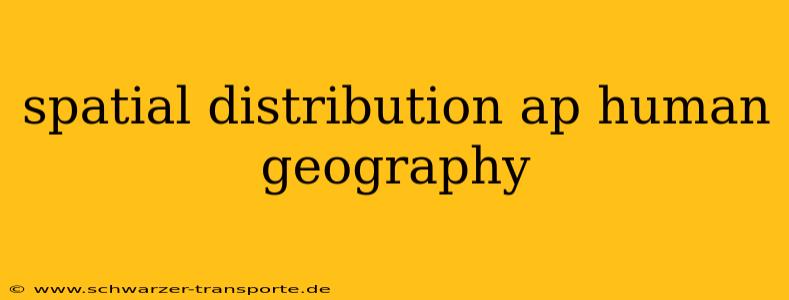Meta Description: Dive into the fascinating world of spatial distribution in AP Human Geography! This comprehensive guide explores key concepts, patterns, processes, and real-world examples to help you master this crucial topic. Learn about different spatial distributions, influencing factors, and how to analyze spatial data effectively. Prepare for your AP Human Geography exam with confidence!
Spatial distribution is a fundamental concept in AP Human Geography. It refers to the arrangement of features across Earth's surface. Understanding spatial distribution helps geographers explain patterns and processes shaping our world. This article will explore this key topic, offering a comprehensive overview for AP Human Geography students.
Key Concepts in Spatial Distribution
Understanding spatial distribution involves analyzing several core concepts:
1. Concentration/Dispersion
- Concentrated: Features clustered closely together. Think of high-density housing in urban areas.
- Dispersed: Features spread widely apart. Consider farms in rural landscapes.
- Agglomerated: Concentrated clusters with some space between clusters. Industrial parks often show this pattern.
2. Density
This refers to the frequency of something within a given area. High density means many features in a small space; low density means fewer features in a larger space. Population density is a common example. We can use arithmetic density (people per square kilometer) or physiological density (people per unit of arable land) for a more nuanced understanding.
3. Pattern
This describes the geometric arrangement of features. Patterns can be regular, random, or clustered. Regular patterns might be seen in planned urban development, while random patterns could characterize the distribution of certain plant species.
Factors Influencing Spatial Distribution
Many factors influence how things are distributed geographically:
- Physical Factors: Climate, topography, and natural resources all play significant roles. For example, population density tends to be lower in mountainous regions.
- Human Factors: Economic activities, political decisions, cultural preferences, and technological advancements shape distributions. The location of manufacturing plants is influenced by factors like access to transportation and labor.
- Historical Factors: Past events continue to influence present-day distributions. Colonial boundaries still affect many countries' political and economic landscapes.
Analyzing Spatial Data
Analyzing spatial patterns involves using various tools and techniques:
- Maps: Cartography is essential for visualizing spatial distribution. Different map types (dot maps, choropleth maps, isopleth maps) showcase distributions in various ways.
- Geographic Information Systems (GIS): GIS software allows for advanced spatial analysis, enabling geographers to overlay different data layers and identify relationships.
- Remote Sensing: Satellite imagery and aerial photography provide valuable data for understanding spatial patterns over large areas.
Types of Spatial Distribution
Several key patterns of spatial distribution are frequently studied:
1. Random Distribution
This is characterized by no discernible pattern; elements are dispersed unpredictably. The distribution of certain types of trees in a forest might approximate this pattern.
2. Clustered Distribution
This pattern shows elements concentrated in specific areas. This is typical for urban areas or areas with high concentrations of a specific resource.
3. Linear Distribution
Elements are arranged in a line along a physical feature like a river or road. Towns along a major transportation route often exhibit this pattern.
Real-World Examples of Spatial Distribution
Numerous real-world examples illustrate the concept:
- Population Distribution: Uneven distribution of people across the globe, concentrated in certain regions due to climate, resources, and historical factors.
- Agricultural Land Use: Specific crops are grown in areas with suitable climate and soil conditions.
- Industrial Location: Industries cluster near resources, transportation routes, and markets.
- Disease Outbreaks: Spreading of infectious diseases is strongly influenced by spatial proximity and patterns of movement.
Conclusion
Understanding spatial distribution is crucial for comprehending the complex patterns and processes shaping our world. By analyzing spatial patterns and the factors driving them, we gain valuable insights into human activities and environmental relationships. Mastering this fundamental concept is key to success in AP Human Geography. Remember to use various techniques like maps, GIS, and remote sensing to analyze spatial data effectively. The ability to identify, explain, and analyze spatial distributions is essential for a deeper understanding of human geography. This will also better equip you to analyze current events through a geographical lens.
